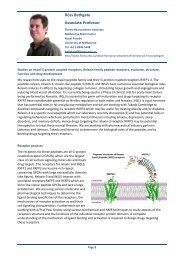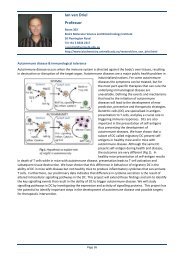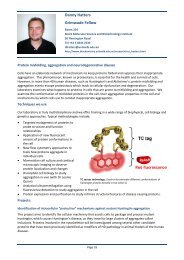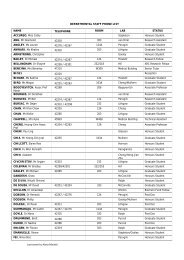Paul Gleeson Professor
Paul Gleeson Professor
Paul Gleeson Professor
You also want an ePaper? Increase the reach of your titles
YUMPU automatically turns print PDFs into web optimized ePapers that Google loves.
c. Regulated endocytosis<br />
Macropinocytosis is a regulated form of endocytosis and is highly active in macrophages and dendritic cells<br />
(antigen presenting cells) where it is a major pathway for the capture of antigens. Despite the importance<br />
of this pathway, the molecular basis for the formation and maturation of macropinosomes is poorly<br />
defined. This project aims to investigate the role of macropinocytosis in antigen uptake by macrophages<br />
and dendritic cells using cell lines and genetically modified mouse lines.<br />
Autoimmunity and molecular immunology<br />
Failure of immunological self‐tolerance often leads to the development of autoimmune diseases, which<br />
afflict up to 5% of the population. The underlying causes of autoimmune diseases are still unknown,<br />
although infections are strong candidates for initiating autoimmunity by promoting the maturation of<br />
dendritic cells (DCs) that present tissue self‐antigens. This project will analyse the relationship between<br />
inflammatory stimuli, the maturation status of DCs that present gastric self‐epitopes and the development<br />
of organ‐specific autoimmunity.<br />
Figure 2. Gastric cells express an<br />
autoantigen which is presented in<br />
the local draining lymph nodes by<br />
migratory dendritic cell<br />
We have established an experimental autoimmune disease of the stomach<br />
(autoimmune gastritis) as a powerful model of organ‐specific autoimmunity<br />
and have identified the gastric autoantigens that are recognized by the selfreactive<br />
effector T cells. CD4 + T cells that mediate the disease recognize the<br />
highly abundant gastric H/K ATPase heterodimer. Immune tolerance to these<br />
gastric self‐antigens occurs primarily in the periphery. Most importantly, we<br />
have also identified a subpopulation of migratory DCs in the draining lymph<br />
node of the stomach that presents the endogenous gastric H/K ATPase<br />
antigen. Hence, we are now able to compare the status of DCs which present<br />
the gastric antigen, from normal mice and mice with autoimmune gastritis, as<br />
a basis for understanding the shift from tolerance to autoimmunity. This<br />
project will involve the isolation of the migratory population of DCs by<br />
standards methods in the lab, analysis of TLR expression of these migratory<br />
DCs and assessment of the impact of different TLR ligands on the maturation<br />
and functional status of these DCs by analysis of cytokine profiles and<br />
activation of gastric‐specific effector T cell responses.<br />
Recent publications<br />
1. van Driel IR, Read S, Zwar TD, <strong>Gleeson</strong> PA. (2005) Shaping the T cell repertoire to a bona fide autoantigen: lessons from<br />
autoimmune gastritis. Curr Opin Immunol, 17, 570–6.<br />
2. Kerr M.C., Lindsay M.R., Luetterforst R., Hamilton N., Simpson F., Parton R.G., <strong>Gleeson</strong> P.A., Teasdale R.D. (2006).<br />
Visualisation of macropinosome maturation by the recruitment of sorting nexins. J. Cell Sci. 119:3967‐80.<br />
3. Derby MC, Zhao Lieu Z, Stow J, Goud B, <strong>Gleeson</strong> PA. (2007). 'The TGN golgin, GCC185, is required for endosome to Golgi<br />
transport and maintenance of Golgi structure'. Traffic, 8: 758–73<br />
4. Read S, Hogan T, Zwar T, <strong>Gleeson</strong> PA, van Driel IR. (2007) 'Prevention of autoimmune gastritis in mice requires extrathymic<br />
T cell deletion.' Gastroenterology, 133(2):547‐58<br />
5. Lieu, Z.Z., Lock, J.G., Hammond, L.A., La Gruta, N. L, Stow, J. L. and <strong>Gleeson</strong>, P.A. (2008). A trans‐Golgi network golgin is<br />
required for the regulated secretion of TNFa in activated macrophages in vivo. Proc. Natl. Acad. Sci USA, 105:3351‐6<br />
6. Houghton F, Chew PL, Lohedo S, Goud B and <strong>Gleeson</strong> PA (2009) The localization of the golgin, GCC185, is independent of<br />
Rab6 and Arl1. Cell 138: 787‐794<br />
7. <strong>Gleeson</strong> PA and Goud, B (2010) TGN golgins, Rabs and cytoskeleton: Regulating the Golgi trafficking highways. Trends<br />
Cell Biol 20(6):329‐36.<br />
8. Chia, PZC and <strong>Gleeson</strong>, PA (2011) The regulation of endosome‐to‐Golgi retrograde transport by tethers and scaffolds.<br />
Traffic (in press)<br />
Page 15









